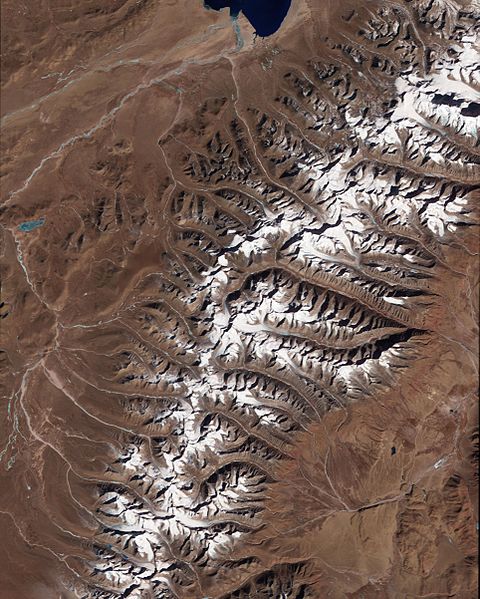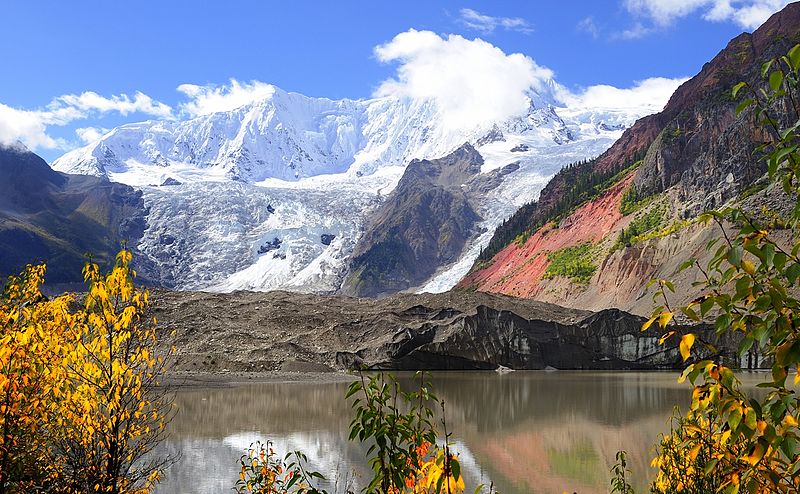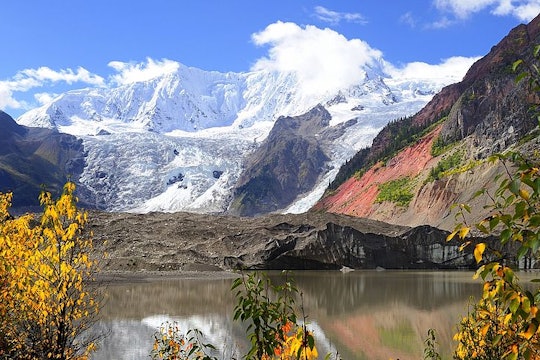Toxic chemicals are being freed from melting glaciers
Scientists are finding decades-old DDT and PCB flowing from the Tibetan Plateau
Life on the Tibetan Plateau is harsh. It's the world’s highest plateau, and winters are cold and inhospitable there. Food is scarce, the air is thin, and hailstorms are common. The people who live there have evolved with genetic mutations that enable them to stay healthy in the challenging environment at "the roof of the world." Nothing, however, could prepare them for the rapid changes now occurring thanks to climate change.
The plateau houses an enormous amount of water in the form of glaciers and alpine lakes, acting as a “water tower” supplying the major rivers that support enormous populations at lower altitudes in China. Rising temperatures are causing more and more of these water stores to thaw, leading to melting permafrost, flooding, landslides, and shrinking glaciers – nearly 18 percent of total glacial coverage (2,900 square miles) has been lost since the 1950s.
Along with changes to the landscape due to melting and alteration of ordinary weather patterns due to rising temperatures, climate change has another threat in store for Tibetan Plateau residents: the release of long-banned toxic chemicals from inside melting glaciers.
Toxins in unexpected places
Pesticides and other contaminants emitted from populated, warmer regions are transported through the air until they reach colder climes. Much like how water condenses on a cold soda can, chemicals from the air are deposited and accumulate in cold, high-altitude regions. DDT, for example, hasn't been used widely since the 1970s, but it's stored in glaciers. So are chemicals like polychlorinated biphenyls (PCBs), which were widely used during the 1960s and 70s in electrical equipment due to their excellent performance as insulators.
We now know that DDT and PCBs can cause cancer, and we've stopped using them. But these chemicals degrade extremely slowly in the environment, so they're still present in our air, water, and ice today, along with many persistent chemicals we currently or recently used, like organic flame retardants.
Studies have found that melting glaciers are releasing DDT, PCBs, and other banned pollutants from glaciers in the Swiss Alps. Scientists also identified melting glaciers as a probable source of DDT to Antarctic wildlife.

Tibet's mountains
Recently, scientists from the China University of Geoscience in Beijing journeyed to the Tibetan Plateau to find out whether glaciers in this region are also releasing toxic pollutants. They measured levels of DDT and several other pesticides in alluvial deposits, which are layers of residue deposited from past glacial melt, at the edge of the Changwengluozha glacier in the central Tibetan Plateau. By digging into layers of glacial melt deposits, the scientists could trace the historical record of pollutant deposition back to 1950.
When they examined the record, the researchers noticed two distinct periods of time when deposition of DDT and other pesticides spiked. The first one occurred when they were heavily used in agriculture throughout China and Southeast Asia (primarily in the 1970s). After that, levels declined in the deposits, as toxic pesticides were banned and emissions to the plateau decreased.
However, they saw a second, unexpected peak in levels in the late 1990s, a period in which temperatures in the Tibetan Plateau increased markedly. They noted that two different pesticides that were originally used for different things, HCH and DDT, increased simultaneously in the 90s, as if they originated from the same source. They hypothesized that this second pulse was likely due to re-release of these pesticides from within the melting glacier.
.jpg)
DDT spraying in the 1950s
The researchers wanted more evidence that these pesticides were being released from the melting glacier, so they looked for additional lines of evidence. They knew that there were two possible sources of these pollutants in their samples: increasing temperatures in populated areas could be causing these pollutants to be emitted from lower-latitude regions and transported to the glacier, or they could have been released from the glacier as it melted.
They turned to a special property of DDT and HCH – they are both chiral compounds, which means the molecules can occur in two distinct configurations which are mirror images of each other. When they’re produced by manufacturers, DDT and HCH are 1:1 mixtures of the two configurations, called enantiomers. But after their release, the two enantiomers are treated differently by some environmental processes. For instance, they are degraded at different rates by microbes.
By tracking whether chemicals measured in deposits were enriched in one enantiomer, researchers could learn more about the sources of these pesticides. They found that during the first peak of pesticide accumulation in the 70s, ratios of enantiomers were similar to the originally manufactured product (1:1). This is because the chemicals were in heavy usage at this time, and so were being directly emitted and then transported to the glacier. In periods where the chemicals were not used as heavily, the ratio was skewed, because the main source of the pesticides was no longer their direct usage and emission, but their re-release from soils and water and transport to the glacier – processes which work differently for the different enantiomers.
They saw that the enantiomeric ratio rapidly approached 1:1 again during the second pulse of pollutants in the 1990s. This ruled out lower latitude sources of these pesticides and identified the melting glacier as the source of these pesticides. This is a previously unrecognized new source of banned toxic pollutants to the Tibetan Plateau.
We can't fully understand the effects of climate change on this and other high-altitude environments unless we understand what the full magnitude of this pulse of pollutants might be, and where these chemicals will go after they've been released. And we still don't have these answers.
The re-release of toxic pollutants from glaciers could have serious consequences for the people who make their homes in the Tibetan Plateau region and beyond. Native peoples who live in extreme polar environments often subsist on hunting and traditionally have diets high in fat and meat (yak meat and milk, specifically, in the Tibetan Plateau). Pesticides like DDT tend to accumulate in the fatty tissues of living things, so increasing levels of persistent pollutants in water due to glacier melt will lead to increasing amounts of these toxic chemicals in the food these people rely on.

Tibet's Midui Glacier
This could mean that communities indigenous to high-altitude regions will be exposed to more and more toxic chemicals as climate change progresses. But it doesn't stop there: scientists don't know where these re-released chemicals could end up.
In my own doctoral research, I found organic contaminants at surprisingly high levels in remote and deep-sea marine environments where we didn't expect them to be. There is still a lot we don't understand about how these compounds are transported from one place to another, and where they will ultimately accumulate. Once they're on the loose, chemicals from glaciers could travel in air or water to other far-flung regions, contaminating other communities' drinking water supplies and food sources.






The suite of analytical chemistry techniques and comparisons employed today to measure environmental pollutants and make sense of their concentrations can be enormous and quite complicated. It’s striking and quite inspiring to hear about the elegant application of an inherent chemical property like stereochemistry informing a complex and large-scale environmental question as described in this article.
I wonder if any follow-up studies have emerged modeling the volatilization of contaminants from glacial melt globally, and what kind of pollutant burden this is imposing in the atmosphere/hydrosphere at large….is this glacial load of pollutants in the kilogram range or in the tons range?
Beyond nerding out over the presented chemical approach, I’d like to reiterate to readers that glacial loss is not restricted to the Tibetan plateau, the Alps, or Antarctica. Glaciers are on the retreat worldwide, with NASA estimating a 400-billion-ton loss of glacial mass globally since 1994, with glaciers in Montana losing more than 85 percent of their area since 1950.
This means that glaciers may be acting as sources of these pollutants around the globe and within the US, facilitating the continued reintroduction of compounds that we have worked very hard to get rid of.